Part 1: The Competition
You know by now that we at Two Girls One Pint really love craft beer—that’s just stating the obvious here (Because “Once you go craft you never go back”). Yup, we love it so much that we wanted to make it ourselves. It only seems natural! Good beer is a journey, an exploration—first is the introduction into what makes a good beer—a variety of malted barley or other grains, a great water source, a variety of hops to add bitterness and aroma, and last but not least, the yeast, which depending on what kind is used is the difference between an ale and a lager, or more specifically, a Belgian Pale Ale or a Pilsner.
And since we know that you, our audience, are already beer-savvy and pride yourself on your hop knowledge, the educational posts are for another day—Let’s jump right to the good part!
We are entering our first homebrew competition! While attending beer festivals, visiting great craft beer bars and learning about our favorite breweries has been a big part of what we do, once in awhile it’s fun to show off a little bit. And nothing is better than beer you made yourself at home.
The Queen of Hops is a female-centered homebrew competition that is being held this Thursday at the Copper Mine Pub in North Arlington, New Jersey, and Two Girls One Pint are representing with their brews! The hard part is over—now it’s time to celebrate.
The competition is sponsored by New Jersey Craft Beer, a Web site and discount program informing New Jersey residents all about their craft beer scene and happenings. Already a member of their great discount program, when we learned about their home-brewing competition, we just had to be a part of it.
Celebrating women and beer is one of our favorite past times, and although there are many strong, powerful women in the beer industry (too many to even mention here), beer is still too often considered a guy thing. Hence NJCB felt the need for this contest, honoring the women who are a part of this growing scene and creating a unique contest for their own homebrew.
Part 2: The Brews
So what did we make? Well, I brewed something I am calling a “Kentucky Cream Ale,” and although this style isn’t widely available commercially, its legend is spread all across the Web and is mentioned in several brew books, including Ray Mosher’s Radical Brewing. Considered a “historical style,” it is believed that the beer was consumed by the “laboring class” around Louisville, KY as a substitute for whiskey, because we all know it’s hard to go back to work after we’ve been hitting the bourbon barrel!
It is sometimes described as a “Common,” which makes me think of the California Common, or steam beer, an almost extinct American style revived by Fritz Maytag of Anchor Brewing Co., an ale that is fermented at ale temperatures but with lager yeasts. I do not really want to refer to my brew as a Common though, because I used ale yeast (American Ale yeast to be exact) and wanted the body and texture to be more along the lines of a Cream Ale, but with two distinct differences: It’s sour and it’s dark!
I did not make an entire 5 gallon batch being that my brew was so experimental, I wanted to do a smaller “test batch” of sort to make it more manageable. My mash bill consisted of 27% flaked maize (corn) a little less than 70% pale 2-row malt (really just a great base that a brewer can use in a variety of ways to compose the body of their brew), and the other 3% some darker malt (Chocolate and Black Patent) to give it the color I was looking for. I wanted dark! Think almost porter dark.
After mashing, I decided to make things weird. As we said in Kentucky during bartending camp, “Shit got weird.” So, I decided to sour my mash after I had just spent an entire hour “making love to it,” (aka stirring the mash in the pot—I like to make it sound more interesting).
I wanted this beer to be sour—not gueze sour or Rodenbach sour, but still have that nice tang like maybe somebody put a sour patch kid in your beer. Why would someone do that? I don’t know: Because they’re a jerk?
I could’ve done this by adding lactic acid or even our popular friend, Brettamyces, but I really didn’t feel like buying all new equipment after this “experiment” (Brett can really funk up your stuff, and I have no interest in creating an entire line of sour beers). So I did what they do in Kentucky when they make that good ‘ole bourbon: I made a sour mash.
While the sour mashes used to create bourbon are at least 51% corn, a beer with that much of an adjunct is not going to be very tasty. After researching the process I was a bit worried: This could go horribly wrong.
The basics? I used the base of a Crockpot warmer (because every good girl has a Crockpot) and kept it on “warm,” while I sat my entire brew kettle with the mash on top. I added a few ounces of unspent grain (to get the bacteria going) and covered the surface with Saran wrap. Then I crossed my fingers and hoped for the best. This could go horribly wrong.
The key was to keep it at between 90 and 140 degrees Fahrenheit, with 110 being the goal. Too low, and the bacteria wouldn’t grow. Too high, and the bacteria would just die off. I wanted some degree of sourness but also feared that the bacteria I created would be the “bad” kind. And then no one would want to drink this beer!
After souring for about 24 hours, I believed it was ready (doing the whole finger test, because how else would I know?). I sparged the grains and then boiled my wort, adding a small amount of Cluster hops at the beginning of my boil and another few ounces after 30 minutes. And then it was into the carboy with the yeast to do its job—to make my awesome beer.
I bottled after 2 weeks and after letting that carbonate in its vessel (I used honey as my fermentable sugar because I like to be natural) for another two weeks, I had beer. My homebrew for the Queen of Hops to be exact.
So how does it taste? While I think it’s fantastic, but I’m a bit bias. It turned out exactly how I wanted it to: A dark, soured Cream Ale. And at about 5% ABV, you can still drink one of these and go back to work—no getting sloshed on whiskey here!
Jennifer Wood, the producer and creator of Two Girls One Pint, brewed a Saison with lavender. While I wasn’t there when she created the brew, she’s posted some great pictures on our Facebook page (please “Like Us”) showing her own brewing process.
Ladies, you have some healthy competition here! We’ll see what the judges have to say on Thursday.
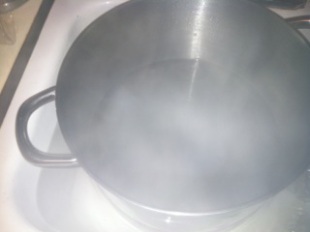
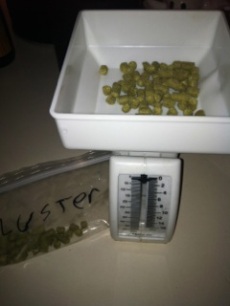
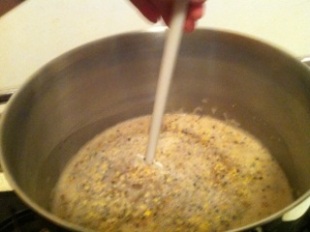
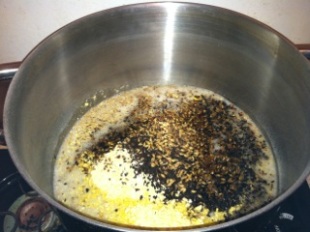
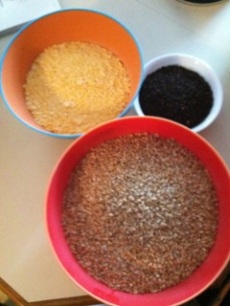
Leave a comment